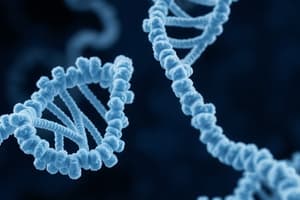Podcast
Questions and Answers
What is the main difference between DNA and RNA in terms of sugar composition?
What is the main difference between DNA and RNA in terms of sugar composition?
- Both DNA and RNA contain the same type of sugar.
- DNA contains deoxyribose, while RNA contains ribose. (correct)
- DNA contains ribose, while RNA contains deoxyribose.
- DNA contains glucose, while RNA contains ribose.
How are nucleotides in a polynucleotide chain linked together?
How are nucleotides in a polynucleotide chain linked together?
- By van der Waals forces between adjacent nucleotides.
- By covalent bonds between the sugar and phosphate groups. (correct)
- By ionic bonds between the nitrogenous bases.
- By hydrogen bonds between nitrogenous bases.
What characterizes the structure of purines compared to pyrimidines?
What characterizes the structure of purines compared to pyrimidines?
- Purines consist of adenine and guanine, while pyrimidines consist of cytosine, thymine, and uracil. (correct)
- Purines are only found in RNA, while pyrimidines are found in DNA.
- Purines have a single six-membered ring, while pyrimidines have a double ring structure.
- Purines have a six-membered ring fused to a five-membered ring, while pyrimidines have a double five-membered ring.
Which statement correctly describes the arrangement of the DNA double helix?
Which statement correctly describes the arrangement of the DNA double helix?
How can molecular biology contribute to understanding evolutionary relationships?
How can molecular biology contribute to understanding evolutionary relationships?
What is the primary role of nucleic acids in living organisms?
What is the primary role of nucleic acids in living organisms?
Which component is NOT part of a nucleotide?
Which component is NOT part of a nucleotide?
What is the function of messenger RNA (mRNA) in protein synthesis?
What is the function of messenger RNA (mRNA) in protein synthesis?
Which of the following bases is found in RNA but not in DNA?
Which of the following bases is found in RNA but not in DNA?
What type of nucleic acid is involved in the process of directing its own replication?
What type of nucleic acid is involved in the process of directing its own replication?
Which structure is responsible for attaching to mRNA during protein synthesis?
Which structure is responsible for attaching to mRNA during protein synthesis?
Which nitrogenous bases are classified as purines?
Which nitrogenous bases are classified as purines?
What term describes the part of a nucleotide that does not include the phosphate group?
What term describes the part of a nucleotide that does not include the phosphate group?
Flashcards
Gene
Gene
The basic unit of inheritance that carries the instructions for building proteins. Made up of DNA.
DNA
DNA
A type of nucleic acid that carries the genetic information of an organism. It is responsible for directing the synthesis of proteins.
RNA
RNA
A type of nucleic acid that is involved in protein synthesis. It carries the genetic information from DNA to the ribosomes, where proteins are made.
Transcription
Transcription
Signup and view all the flashcards
Translation
Translation
Signup and view all the flashcards
Nucleotide
Nucleotide
Signup and view all the flashcards
Pyrimidines
Pyrimidines
Signup and view all the flashcards
Purines
Purines
Signup and view all the flashcards
What is a Nucleoside?
What is a Nucleoside?
Signup and view all the flashcards
What is a Nucleotide?
What is a Nucleotide?
Signup and view all the flashcards
How are DNA and RNA polymers formed?
How are DNA and RNA polymers formed?
Signup and view all the flashcards
Difference in Structure between DNA and RNA
Difference in Structure between DNA and RNA
Signup and view all the flashcards
How is DNA used in evolutionary studies?
How is DNA used in evolutionary studies?
Signup and view all the flashcards
Study Notes
Nucleic Acids
- Nucleic acids store, transmit, and help express hereditary information.
- The amino acid sequence of a polypeptide is programmed by a gene.
- Genes are made of DNA, a nucleic acid composed of nucleotides.
- DNA provides directions for its own replication.
- DNA directs the synthesis of messenger RNA (mRNA), which then controls protein synthesis.
- Protein synthesis occurs on ribosomes.
- There are two types of nucleic acids: deoxyribonucleic acid (DNA) and ribonucleic acid (RNA).
Components of Nucleic Acids
- Nucleic acids are polymers called polynucleotides.
- Each polynucleotide is made of monomers called nucleotides.
- Each nucleotide consists of a nitrogenous base, a pentose sugar, and one or more phosphate groups.
- The portion of a nucleotide without the phosphate group is called a nucleoside.
Nucleotide Polymers
- Nucleotide polymers are linked together to form a polynucleotide.
- Adjacent nucleotides are joined by covalent bonds between the -OH group on the 3' carbon of one nucleotide and the phosphate on the 5' carbon of the next.
- These links form a sugar-phosphate backbone with nitrogenous bases as appendages.
- The sequence of bases along a DNA or mRNA polymer is unique for each gene.
Structures of DNA and RNA Molecules
- RNA molecules usually exist as single polypeptide chains.
- DNA molecules have two polynucleotide strands that spiral around each other, forming a double helix.
- In the DNA double helix, the two backbones run in opposite 5'→3' directions (antiparallel).
- One DNA molecule includes many genes.
DNA and Protein as Evolutionary Measures
- The linear sequences of nucleotides in DNA molecules are passed from parents to offspring.
- Two closely related species show more similarity in their DNA than distantly related species.
- Molecular biology can be used to evaluate evolutionary relationships between species.
Nitrogenous Bases
- The nitrogenous bases in DNA pair up through hydrogen bonds: adenine (A) with thymine (T), and guanine (G) with cytosine (C).
- In RNA, thymine is replaced by uracil (U), so adenine (A) pairs with uracil (U).
- Complementary base pairing can occur between two RNA molecules or between parts of the same molecule.
Studying That Suits You
Use AI to generate personalized quizzes and flashcards to suit your learning preferences.




